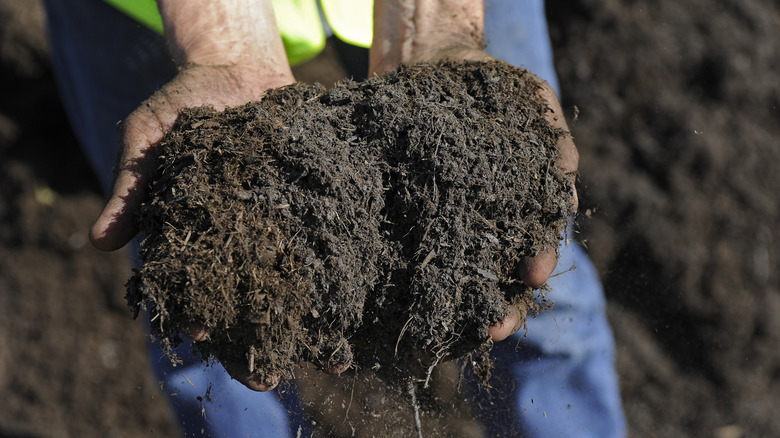The Best Type Of Compost To Keep Your Yard's Trees Healthy
Trees are an investment in the value of your home. Not only do they add beauty and interest to the landscape, but large trees provide shade, reducing your summer cooling costs. It takes time, but in 15 years, a shade tree can lower your electric bill by 12%, according to Constellation. Those savings add up over time and using less electricity makes your home more environmentally friendly. You can ensure your trees are as healthy as possible by using compost when you plant them and continuing to apply it throughout their lifespan.
Regardless of where you live, any kind of compost is good to use for both new and existing trees. Although there are some differences between the options, what you use is really up to you, based on what is available in your area and your budget. With that in mind, knowing the basics of different types of compost can help you make the best choice for your landscape.
Compost options for trees
Compost may just look like soil, but it's actually a dense collection of nutrients. There are a few kinds of compost available at your local garden center. A compost-only product is made primarily of organic matter, like leaves and food scraps. Some brands include additional fertilizers or other ingredients to improve the overall quality. You can also purchase "pure" compost that is comprised of only composted material. The packaging on bags of compost tells you what is included. A combination of compost and decomposed manure is a popular choice because it's often easy to find inexpensively. This product includes excess waste from commercial farming, which can be used on lawns and in gardens.
Mushroom compost is a slightly different option because it's a byproduct of mushroom farming. When the medium for commercial mushroom growing is no longer suitable for this process, it's allowed to further decompose before being packaged as mushroom compost. This material tends to be excellent for retaining moisture and, although it's no longer suitable for growing mushrooms, it's an excellent choice for most ornamental and shade trees — with one exception. This medium is not ideal for use with fruit trees. Unlike compost and manure-based options, mushroom compost tends to be alkaline and is not ideal for fruit-bearing trees, especially citrus which requires more acidic soil. Regardless of the best type of compost for your yard trees, all compost contains the macro and micronutrients they need to thrive.
How to use compost around trees
When it's time to use compost to plant a new tree, dig an area that is two to three times as wide as your tree's root ball. Make sure it's only deep enough for the tree to sit in the hole where the top of the root ball is level with the surface of the soil. For example, if the root ball is 24 inches wide and deep, your hole should be about 4 feet in diameter and 24 inches deep. Mix the soil you removed with about 20% compost, put your tree in place, then backfill the hole with your soil and compost mixture. Gently tamp down the soil around the trunk and water thoroughly.
To use compost for existing trees, you can basically treat it like mulch once a year. Place compost around the base of your tree about 2 inches deep, leaving about 6 inches between the trunk and the compost. For smaller trees in a landscaped area, apply compost from near the trunk out to the edge of the tree's canopy. For larger shade trees, a 6-foot diameter of compost around the base will improve soil and add nutrients. Cover the compost with about two inches of mulch for a finishing touch that will help retain moisture. Never apply compost or mulch against the tree trunk. This can lead to rot and pest problems and may destroy your investment.


